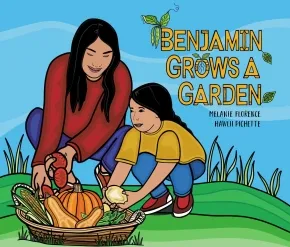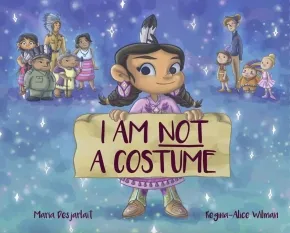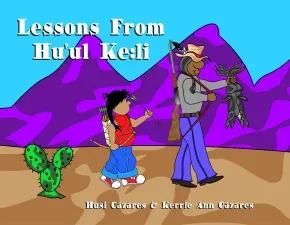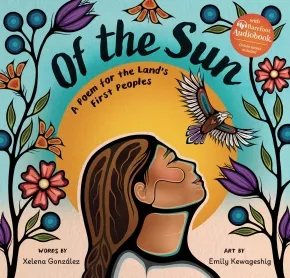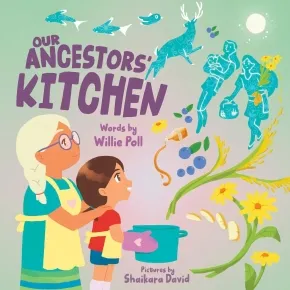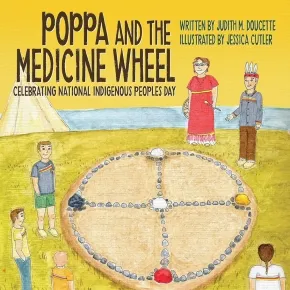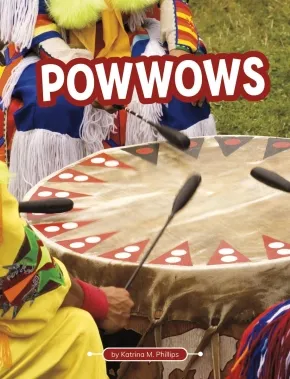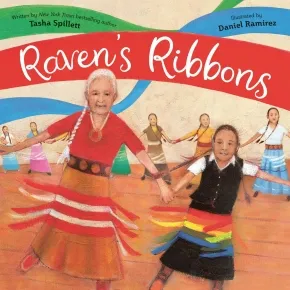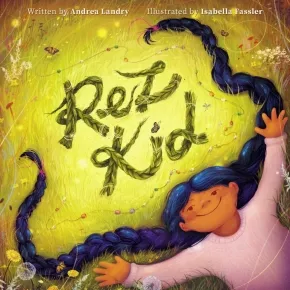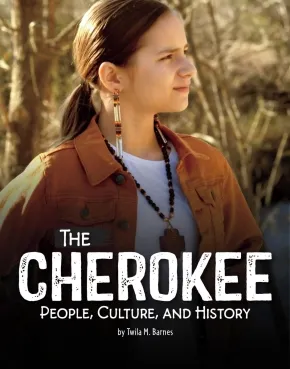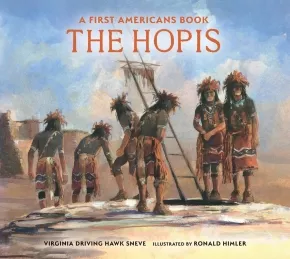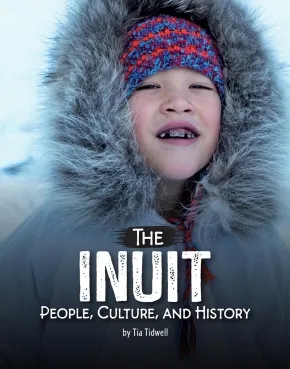
Customs and Traditions
1
-
15
of
123 Results;
Sort By
Go To
of 9
A Day With Hu'ul
$19.95
Artists:
Format:
Hardcover
Text Content Territories:
Indigenous American; Native American; Tohono O'oodam;
ISBN / Barcode: 9798992176308
Synopsis:
Synopsis:
Grandmother, Why do we do the things we do?
How a young girl is raised by her grandmother on the Tohono O'odham Indian Reservation. The book denotes various aspects of O'odham himdag (culture) and begins with waking up in the morning and then preparing for the day and engaging in several different responsibilities. Various daily chores and activities such as preparation of different food, basket weaving, pottery making, household chores and cultural undertakings are highlighted.
Educator & Series Information
Recommended for ages 3 to 5 by the publisher, but this book contains a lot of text and may be more suitable for older children.
This book includes many O'odham words, but it is not a dual-language book. A glossary is included. O'odham is a Native American language spoken by several tribes in the American Southwest and Northern Sonoran Mexico.
This book is part of the Tohono O'odham series.
Subjects / Themes: Daily Life, Home, Family, Community, Culture
Additional Information
48 pages | 11.00" x 9.00" | colour illustrations | Hardcover
Benjamin Grows a Garden
$21.99
Artists:
Format:
Hardcover
Text Content Territories:
Indigenous Canadian; First Nations; Cree (Nehiyawak);
ISBN / Barcode: 9781525303210
Synopsis:
Synopsis:
Readers follow along step-by-step as Benjamin plants and cares for his garden and imagines the harvest to come.
Benjamin loves springtime. The grass grows bright green, the birds sing sweet songs and, best of all, Benjamin and his mother start their garden. In just the right order, they plant mahtâmin (corn), pîmiciwacis (beans), and osawipak (squash) for Three Sisters Soup. They plant strawberries to serve with bannock, then zucchini, tomatoes, cucumbers. Benjamin and his mom lovingly tend to the garden and watch it grow into a plentiful harvest with enough to share. Throughout the whole summer, Benjamin dreams about the fall, when they’ll have all the ingredients for a feast – and everyone will be invited!
In this heartwarming story, award-winning author Melanie Florence evocatively portrays the pleasures and rewards of growing and sharing food. The steps of the gardening process – digging holes, planting seeds, watering – are carefully described, and the yearly cycle of growing, harvesting, eating and then starting again the next year is emphasized. Special attention is paid to the tradition of planting corn, beans and squash together so that each plant by its nature helps the others grow. Benjamin and his mother use Cree words throughout the story, and a pronunciation guide is included at the back of the book for further inquiry. Vivid illustrations by Hawlii Pichette make this a perfect follow-up to the author and illustrator duo’s previous book, Benjamin’s Thunderstorm.
Reviews
"A comforting tale of cohabitation between humans and nature." — School Library Journal, April 2025
Educator Information
Recommended for ages 3 to 7.
Includes Cree words throughout the story. A pronunciation guide is included at the back of the book.
Curriculum Connections: Caring; Growth and changes in plants; Indigenous peoples; Patience; Plants; Word recognition
This book is part of the Benjamin Outdoors series. From dancing in the rain with thunder for a drum to planting a vegetable garden with his mom, Benjamin loves being in nature. With evocative text and vibrant art, this delightful picture book series celebrates the joys of spending time outdoors and weaves in nature-related Cree words.
Additional Information
40 pages | 10.00" x 8.50" | Hardcover
Celebrating Potlatches
$21.95
Artists:
Format:
Hardcover
Text Content Territories:
Indigenous Canadian; First Nations; Tsimshian (Ts'msyen); Nisga'a;
ISBN / Barcode: 9781771746564
Synopsis:
Synopsis:
“Papa, what is a Potlatch?”
Inspired by Ts’msyen Chief William Beynon’s historic notebooks on Potlatches in the Gitxsan village of Gitsegukla, Celebrating Potlatches pairs intergenerational storytelling with beautiful illustrations to honour Indigenous traditions. From the award-winning author of Oolichan Moon and the accomplished illustrator of Be a Good Ancestor, this book recounts the 1885 Potlatch ban and the resilience of the communities who fought to keep their traditions alive.
Reviews
“Heartfelt and timely, Celebrating Potlatches gifts readers with cultural teachings through an intergenerational account of Indigenous resilience. This book is a beautiful tribute to the author’s great-grandfather, William Beynon, whose life’s work documenting oral histories of Sm’algya̱x-speaking Peoples and their Potlatches continues to be foundational to our cultural resurgence today.” – Sm Łoodm ‘Nüüsm (Dr. Mique’l Dangeli), Sm’algya̱x language expert and Assistant Professor of Indigenous Arts at the University of Victoria
“This beautiful book shares the importance of community, culture, and identity. As you make your way through the pictures and words, they bring you to an understanding of how important the Potlatch ceremony was and continues to be for Indigenous Peoples.” – Carolyn Roberts, educator, speaker, and author of Re-Storying Education
Educator Information
Recommended for ages 4 to 8.
Through this conversational historic account, readers can learn alongside the narrator as his Papa shares his wisdom about the rich history of the Potlatch.
Curriculum Connections
- Early literacy – listening, reading, and discussing
- Art – traditional Indigenous art, drumming, and regalia
- Social studies – the 1885 Potlatch ban, history of Indigenous Peoples, connection to community
- Social responsibility – uplifting ourselves and others, honouring traditions
- Indigenous knowledge and traditions – traditional teachings, Potlatch ceremonies, intergenerational storytelling
Two free, downloadable lesson plans—one for kindergarten to Grade 1 and one for Grades 2 to 3—provide connections to Social Studies curriculum.
Additional Information
32 Pages | 10" x 8.5" | Hardcover
I Am Not a Costume
$22.99
Artists:
Format:
Hardcover
Text Content Territories:
Indigenous American; Native American; Anishinaabeg; Ojibwe (Chippewa);
ISBN / Barcode: 9781778540738
Synopsis:
Synopsis:
I am not a costume.
Ayasha’s school is having a costume party and she is so excited!
But when Ayasha arrives at school and sees other students wearing fake regalia, she is confused and upset. She doesn’t understand why they think her culture is a costume. Ayasha turns to her family and together they come up with a way to teach her classmates about her culture and how to honor her people respectfully.
Educator Information
Recommended for ages 6+.
Additional Information
32 pages | 8.50" x 11.00" | Hardcover
Lessons From Hu'ul Ke:li
$19.95
Artists:
Format:
Hardcover
Text Content Territories:
Indigenous American; Native American; Tohono O'oodam;
ISBN / Barcode: 9798992176315
Synopsis:
Synopsis:
How a young boy is raised by his grandfather on the Tohono O'odham Indian Reservation. The book denotes various aspects of O'odham himdag (culture) and begins with a simple question that the boy asks his Hu'ul Ke:li (Grandfather) with a culturally relevant answer as to why they do the things they do during the day. Various activities include waking up early in the morning and asking why they do so - to daily chores and activities such as tending horses, working in the garden, hauling water, and gathering food/medicine in the desert.
Educator & Series Information
Recommended for ages 3 to 5 by the publisher, but this book contains a lot of text and may be more suitable for older children.
This book includes many O'odham words, but it is not a dual-language book. A glossary is included.
This book is part of the Tohono O'odham series.
Subjects / Themes: Family, Daily Life, Health, Home, Culture
Additional Information
48 pages | 11.00" x 9.00" | colour illustrations | Hardcover
Of the Sun: A Poem for the Land's First Peoples
$22.99
Format:
Hardcover
Text Content Territories:
Indigenous American; Indigenous Canadian; Indigenous Caribbean; Indigenous Peoples in Mexico; Indigenous South American;
Grade Levels: Preschool; Kindergarten;
ISBN / Barcode: 9798888596500
Synopsis:
Synopsis:
A powerful and hopeful ode to Indigenous children.
Indigenous. Native. On this land, you may roam.
Child of the sun, on this land, you are home.
Of the Sun is an uplifting and mighty poem that wraps the Indigenous children of the Americas in reassuring words filled with hope for a brighter future and reminders of their bond and importance to the land. Each page fills them with pride and awe of their cultural heritage and invites them to unite and inspire change in the world.
Paired with powerful art reflecting cultures of various Indigenous Nations and Tribes, the poem offers all readers a sense of the history and majesty of the land we live on and how we can better care for ourselves and the world when we recognize our connection to the land and to each other.
Written by Xelena González, poet and activist in the Native and Latinx communities, and an enrolled member of the Tap Pilam Coahuiltecan Nation. Bold illustrations by prominent Anishinaabe illustrator Emily Kewageshig depict landscapes across the Americas and children from many backgrounds
Endnotes provide more information on Native and Indigenous unity and activism in younger generations
Reviews
"Of The Sun is a loving homage to the Indigenous peoples of this land—both in González’s beautiful, lyrical poem and Kewageshig’s warm, vibrant Anishinaabe-styled artwork. A wonderful read aloud you must add to bookshelves at home, at school, and in community!" - Traci Sorell, award-winning author of We Are Grateful Otsaliheliga and At The Mountain’s Base
"A luminous song, poem, promise
of cultures and connection,
of kinship and caring,
for Indigenous children across the continent." - Cynthia Leitich Smith, author of Jingle Dancer
Educator Information
Recommended for ages 3 to 5.
Subjects / Themes / Topics Included: Indigenous Peoples in the Americas; Poetry; Land Connection; Inuit Clothing; Traditional Hair Bun (tsiiyéél); Concheros Dance; Three Sisters; La Danza de la Flor de Piña; Smoke Dance; Jingle Dress Dance; Manoomin (Wild Rice); English Words from Indigenous Languages; Indigenous Farming Practices; Bison; Land Back Movement.
Additional Information
32 pages | 10.00" x 9.75" | Hardcover
Our Ancestors' Kitchen
$23.99
Format:
Hardcover
Text Content Territories:
Indigenous Canadian;
ISBN / Barcode: 9781773219622
Synopsis:
Synopsis:
A poignant and poetic picture book celebrating traditional Indigenous harvesting, foods, and the connections that these build for all our relations.
It’s a special day: the young protagonist in this memorable story is learning her grandfather’s favorite recipe from her grandmother! As each ingredient is prepared for this special dish, readers will be eager to follow along as they are transported back to each instance of gathering, hunting, and harvesting foods in the traditional ways throughout the seasons.
Willie Poll’s poetic voice leads the readers through the seasons and what Mother Earth offers to us in nature in this beautiful celebration of the Earth, our foods, our family, and the importance of grieving those we love. With an emphasis on the importance of thanking the land for what is given to us, sharing with our community, and offering a plate to our ancestors, this gentle and thoughtful tale will resonate with readers young and old alike. Shaikara David’s bright and inviting illustrations carry the cooking experience from the kitchen, to the forest, and back again.
Featuring an author’s note on traditional harvesting practices and a recipe for Nuwish, Our Ancestors’ Kitchen is a joyous exploration of love, food, and culture.
Educator Information
Recommended for ages 4 to 7.
Additional Information
36 pages | 9.75" x 9.75" | Hardcover
Poppa and the Medicine Wheel
$18.95
Format:
Paperback
ISBN / Barcode: 9781774572535
Synopsis:
Synopsis:
June 21 is celebrated all over Turtle Island (North America) as National Indigenous People’s Day. François and his friends are excited to celebrate their first public commemoration of this day with Poppa. They will host a morning sunrise ceremony, including Poppa’s teaching on the Seven Lessons of the Mi’kmaw Medicine Wheel.
In this third book of the “Poppa” series, Poppa celebrates his first National Indigenous People’s Day with his Mi’kmaw Community of St. George’s, Newfoundland and Labrador. He can finally do so without fear of discrimination or oppression. After many years of having to hide his Indigenous ancestry, due to the colonial assimilation of his generation, Poppa’s grandson, François, invites him to his school as a respected Mi’kmaw Elder.
Poppa realizes with much joy that his Indigenous culture is bursting with revitalization and renewed pride in a heritage he feared would be lost and forgotten forever. He does not have to practise his cultural ceremonies in private any longer.
Come, join us as we rediscover the teachings of our Mi’kmaw Medicine Wheel and how our ancestors depended on it as a valuable teaching tool for our Peoples. The lessons of the Medicine Wheel are deeply profound and rich with Indigenous spirituality. The Medicine Wheel begs the utmost respect for the Creator as well as every other living creature in existence.
We are all connected in this great circle of life, and we are encouraged to share in each other’s life journey with the help of our Spirit Guides and ancestors’ guidance. Poppa invites us to participate in celebrating the joy of this day with him. Let’s all seek to find our own balance and reconciliation with love and acceptance that can be found within the realms of our own Mi’kmaw Medicine Wheel.
Educator & Series Information
Recommended for ages 5 to 12.
This book is part of the Poppa series.
Additional Information
32 pages | 8.50" x 8.50" | Paperback
Powwows
$11.99
Format:
Paperback
Text Content Territories:
Indigenous American; Native American;
ISBN / Barcode: 9798875220005
Synopsis:
Synopsis:
Powwows are about dancing! Indigenous people in America come together at powwows to celebrate their culture and traditions with drumming, singing, and dancing. Together they remember their history and honor their ancestors. Dancers show off their best moves and fancy regalia in dances that tell stories or remember important moments in history. Lively photos and easy-to-read text help readers learn about contemporary powwow dances and traditions and their roots in the past. Readers will discover how Indigenous traditions honor the past and celebrate the present.
Educator Information
Recommended for ages 5 to 8.
Additional Information
32 pages | 7.00" x 9.00" | Paperback
Raven's Ribbons
$22.95
Artists:
Format:
Hardcover
Text Content Territories:
Indigenous Canadian;
ISBN / Barcode: 9781771475662
Synopsis:
Synopsis:
A joyous celebration of gender expression through an Indigenous lens, by New York Times bestselling author Tasha Spillett and Ojibwe elder Daniel Ramirez
Raven loves round dances. The drums sing to the people, and the people dance to their songs. Raven especially loves dancing with his grandma, sidestepping to the rhythm of the drums. His favourite part of all is watching the ribbon skirts swirl like rainbows.
"Nohkum, do you think a boy could wear a ribbon skirt?" Raven asks his grandmother one day. She tells him she has lived for a long time, but she has never seen it. That evening, she sews late into the night, and Raven awakes to a rainbow skirt of his own. "I've lived for a long time," his grandma says, "and I'm lucky to see beautiful things that I've never seen before." At the next dance, Raven wears the swirl of unique ribbons with pride.
With illustrations infused with joy and colour, this moving intergenerational story celebrates self-expression, honouring traditions, and finding room for reinvention.
Reviews
"Weaves Two-Spirit self-expression and collective belonging into a beautiful tribute to Indigenous heritage." — Kirkus Reviews - STARRED REVIEW
"Cree author Spillett (I Sang You Down from the Stars) captures the joy of the round dance, and a feeling of belonging and connection offered in intergenerational Indigenous community." — Publishers Weekly - STARRED REVIEW
"[A] welcome story about an Indigenous child's gender expression." — The Horn Book
Educator Information
Recommended for ages 4 to 7.
Additional Information
32 pages | 9.00" x 9.00" | Hardcover
Rez Kid
$21.99
Artists:
Format:
Hardcover
Text Content Territories:
Indigenous Canadian; First Nations; Anishinaabeg;
ISBN / Barcode: 9781525311253
Synopsis:
Synopsis:
A celebration of traditional ways of life and the power of sharing what we have.
”Rez kid!“ The girl ignores the taunt as she hurries to the back of the school bus. She just wants to get home to the reservation, where she can feel safe. One by one, she tells her mom, nóhkom, moshum and aunty about what happened. And one by one they offer her advice on what to do. Each one has a different idea, but each idea is the same at heart: share something from the reservation with the other children. The girl listens, but decides to come up with her own idea. And, as with everything else about her life as a rez kid, her idea grows out of all she has been given by those who came before her.
Andrea Landry has written a beautiful story that celebrates Indigenous ways of life and encourages readers to be proud of who they are. The traditions practiced on the girl’s reservation are showcased as she beads, harvests medicine, gardens and rides horseback with her elders. Isabella Fassler’s stunning art, with swirls of bold colors, evokes the majesty and splendor of nature. The message of showing kindness in response to aggression offers a powerful lesson for all readers. This book could augment social studies lessons on Indigenous cultures and character education conversations about courage, compassion and inclusiveness. An author’s note gives a brief history of reservations/reserves.
Educator Information
Recommended for ages 4 to 7.
Curriculum Connections: Compassion; Courage; Empathy; Inclusiveness; Indigenous peoples; Rural communities
Additional Information
32 pages | 10.00" x 10.00" | Hardcover
The Cherokee: People, Culture, and History
$11.99
Format:
Paperback
Text Content Territories:
Indigenous American; Native American; Cherokee;
ISBN / Barcode: 9798875208218
Synopsis:
Synopsis:
Vibrant traditions, rich histories, and strong voices—that’s the Cherokee Nation. In this inspiring nonfiction book for young readers, discover more about the people, places, and culture of one of the United States’ largest Indigenous groups. Explore how the Cherokee people still survive—and thrive—by safeguarding their language, reviving customs, and upholding celebrations, like the annual Cherokee National Holiday that honors their heritage. Through interactive activities and engaging features—including maps, timelines, recipes, and crafts—Cherokee author Twila M. Barnes provides young learners with important insights into the past, present, and future of the Cherokee people.
Educator & Series Information
Recommended for ages 8 to 11.
This book is part of the Indigenous Peoples series.
Additional Information
32 pages | 7.00" x 9.00" | Paperback
The Hopis
$12.49
Artists:
Format:
Paperback
Text Content Territories:
Indigenous American; Native American; Hopi;
ISBN / Barcode: 9780823460946
Synopsis:
Synopsis:
Award-winning author Virginia Driving Hawk Sneve introduces young readers to the Hopi people.
Did you know that the Hopi people have always lived on three mesas, big flat-topped hills, in Arizona? This accessible nonfiction picture book introduces the Hopis’ creation story, history, beliefs, daily ways of life, and more. Learn about the Hopi secret societies, underground kivas, kachina masks, the snake dance, and more.
Expertly reviewed by members of the Hopi tribe, this updated edition provides the most up to date and accurate information on the Hopi people of the past and present. Historical information is accompanied by a section on modern life.
Educator & Series Information
Recommended for ages 7 to 10.
This book is part of the First Americans series.
Additional Information
32 pages | 10.50" x 9.50" | Paperback
The Inuit: People, Culture, and History
$11.99
Format:
Paperback
Text Content Territories:
Indigenous American; Alaska Native; Inupiat (Alaskan Inuit);
ISBN / Barcode: 9798875208294
Synopsis:
Synopsis:
Colorful celebrations, ancient histories, and enduring customs—that’s the Inuit people. In this insightful nonfiction book for young readers, discover more about the people, places, and customs that connect Inuit communities across the vast Arctic landscape. Explore how the Inuit people thrive in Earth’s northernmost regions by honoring their language, preserving traditional ways of life, and gathering for celebrations, such as Kivgiq, a joyful festival of music, drumming, and dance. Through interactive activities and engaging features—including maps, timelines, recipes, and stories—Iñupiaq author Tia Tidwell offers young learners valuable insights into the past, present, and future of this remarkable culture.
Educator & Series Information
Recommended for ages 8 to 11.
This book is part of the Indigenous Peoples series.
Additional Information
32 pages | 7.00" x 9.00" | Paperback
The Lakota: People, Culture, and History
$11.99
Format:
Paperback
Text Content Territories:
Indigenous American; Native American; Sioux; Lakota;
ISBN / Barcode: 9798875208379
Synopsis:
Synopsis:
Time-honored values, majestic landscapes, and a resilient spirit—that's the Lakota Nation. In this insightful nonfiction book for young readers, discover more about the people, places, and heritage of Lakota communities across the Northern Plains. Explore how the Lakota people continue to thrive by preserving their language, practicing timeless traditions, and celebrating respected ceremonies, like the annual Sun Dance, which brings relatives together in community and prayer. Through interactive activities and engaging features—including maps, timelines, recipes, and crafts—Lakota author Tracy Hauff introduces young learners to the past, present, and future of this vibrant culture.
Educator & Series Information
Recommended for ages 8 to 11.
This book is part of the Indigenous Peoples series.
Additional Information
32 pages | 7.00" x 9.00" | Paperback
Sort By
Go To
of 9



